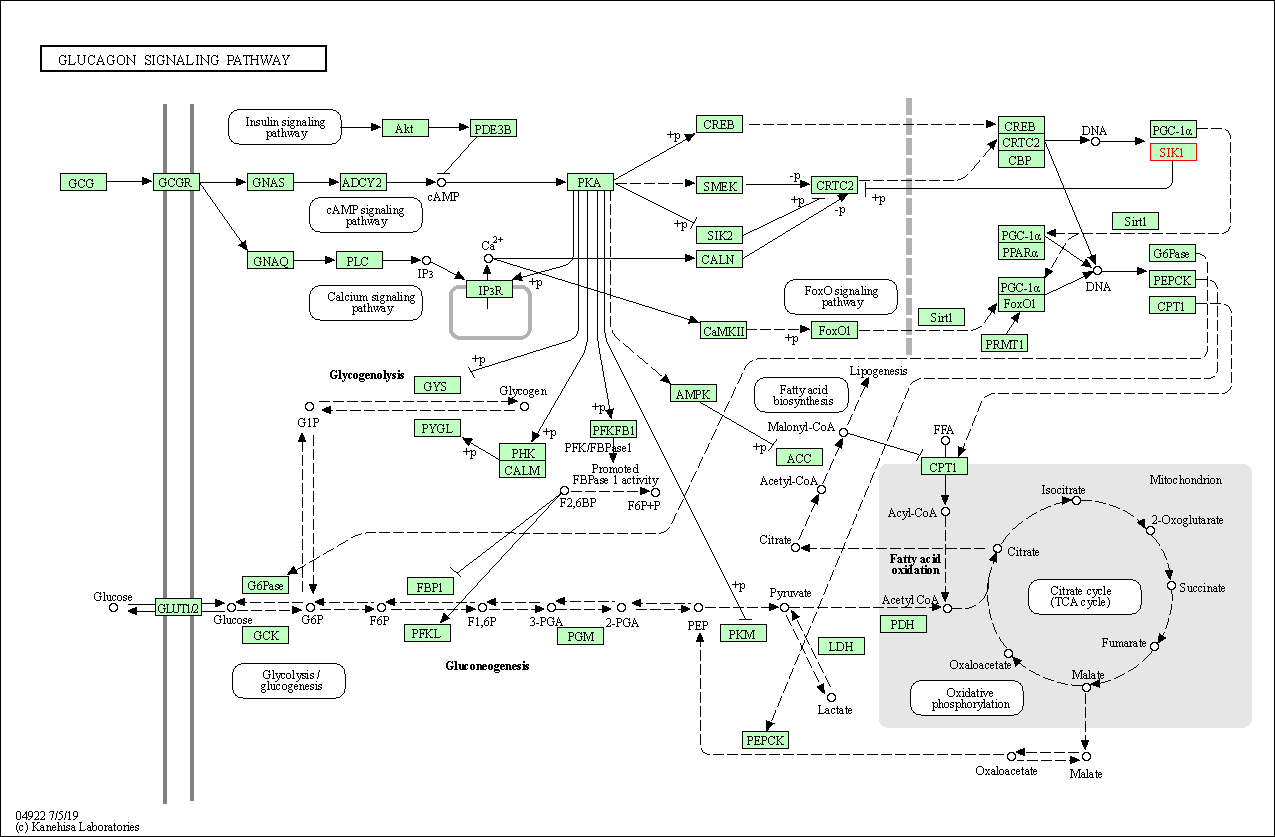Target Information
| Target General Information | Top | |||||
|---|---|---|---|---|---|---|
| Target ID |
T11317
(Former ID: TTDI03529)
|
|||||
| Target Name |
Salt-inducible kinase 1 (SIK1)
|
|||||
| Synonyms |
Serine/threonine-protein kinase SNF1LK; Serine/threonine-protein kinase SNF1-like kinase 1; Serine/threonine-protein kinase SIK1; SNF1LK; SIK-1; SIK
Click to Show/Hide
|
|||||
| Gene Name |
SIK1
|
|||||
| Target Type |
Literature-reported target
|
[1] | ||||
| Function |
Phosphorylates HDAC4, HDAC5, PPME1, SREBF1, CRTC1/TORC1. Inhibits CREB activity by phosphorylating and inhibiting activity of TORCs, the CREB-specific coactivators, like CRTC2/TORC2 and CRTC3/TORC3 in response to cAMP signaling. Acts as a tumor suppressor and plays a key role in p53/TP53-dependent anoikis, a type of apoptosis triggered by cell detachment: required for phosphorylation of p53/TP53 in response to loss of adhesion and is able to suppress metastasis. Part of a sodium-sensing signaling network, probably by mediating phosphorylation of PPME1: following increases in intracellular sodium, SIK1 is activated by CaMK1 and phosphorylates PPME1 subunit of protein phosphatase 2A (PP2A), leading to dephosphorylation of sodium/potassium-transporting ATPase ATP1A1 and subsequent increase activity of ATP1A1. Acts as a regulator of muscle cells by phosphorylating and inhibiting class II histone deacetylases HDAC4 and HDAC5, leading to promote expression of MEF2 target genes in myocytes. Also required during cardiomyogenesis by regulating the exit of cardiomyoblasts from the cell cycle via down-regulation of CDKN1C/p57Kip2. Acts as a regulator of hepatic gluconeogenesis by phosphorylating and repressing the CREB-specific coactivators CRTC1/TORC1 and CRTC2/TORC2, leading to inhibit CREB activity. Also regulates hepatic lipogenesis by phosphorylating and inhibiting SREBF1. In concert with CRTC1/TORC1, regulates the light-induced entrainment of the circadian clock by attenuating PER1 induction; represses CREB-mediated transcription of PER1 by phosphorylating and deactivating CRTC1/TORC1. Serine/threonine-protein kinase involved in various processes such as cell cycle regulation, gluconeogenesis and lipogenesis regulation, muscle growth and differentiation and tumor suppression.
Click to Show/Hide
|
|||||
| BioChemical Class |
Kinase
|
|||||
| UniProt ID | ||||||
| EC Number |
EC 2.7.11.1
|
|||||
| Sequence |
MVIMSEFSADPAGQGQGQQKPLRVGFYDIERTLGKGNFAVVKLARHRVTKTQVAIKIIDK
TRLDSSNLEKIYREVQLMKLLNHPHIIKLYQVMETKDMLYIVTEFAKNGEMFDYLTSNGH LSENEARKKFWQILSAVEYCHDHHIVHRDLKTENLLLDGNMDIKLADFGFGNFYKSGEPL STWCGSPPYAAPEVFEGKEYEGPQLDIWSLGVVLYVLVCGSLPFDGPNLPTLRQRVLEGR FRIPFFMSQDCESLIRRMLVVDPARRITIAQIRQHRWMRAEPCLPGPACPAFSAHSYTSN LGDYDEQALGIMQTLGVDRQRTVESLQNSSYNHFAAIYYLLLERLKEYRNAQCARPGPAR QPRPRSSDLSGLEVPQEGLSTDPFRPALLCPQPQTLVQSVLQAEMDCELQSSLQWPLFFP VDASCSGVFRPRPVSPSSLLDTAISEEARQGPGLEEEQDTQESLPSSTGRRHTLAEVSTR LSPLTAPCIVVSPSTTASPAEGTSSDSCLTFSASKSPAGLSGTPATQGLLGACSPVRLAS PFLGSQSATPVLQAQGGLGGAVLLPVSFQEGRRASDTSLTQGLKAFRQQLRKTTRTKGFL GLNKIKGLARQVCQAPASRASRGGLSPFHAPAQSPGLHGGAAGSREGWSLLEEVLEQQRL LQLQHHPAAAPGCSQAPQPAPAPFVIAPCDGPGAAPLPSTLLTSGLPLLPPPLLQTGASP VASAAQLLDTHLHIGTGPTALPAVPPPRLARLAPGCEPLGLLQGDCEMEDLMPCSLGTFV LVQ Click to Show/Hide
|
|||||
| 3D Structure | Click to Show 3D Structure of This Target | AlphaFold | ||||
| Cell-based Target Expression Variations | Top | |||||
|---|---|---|---|---|---|---|
| Cell-based Target Expression Variations | ||||||
| Different Human System Profiles of Target | Top |
|---|---|
|
Human Similarity Proteins
of target is determined by comparing the sequence similarity of all human proteins with the target based on BLAST. The similarity proteins for a target are defined as the proteins with E-value < 0.005 and outside the protein families of the target.
A target that has fewer human similarity proteins outside its family is commonly regarded to possess a greater capacity to avoid undesired interactions and thus increase the possibility of finding successful drugs
(Brief Bioinform, 21: 649-662, 2020).
Human Pathway Affiliation
of target is determined by the life-essential pathways provided on KEGG database. The target-affiliated pathways were defined based on the following two criteria (a) the pathways of the studied target should be life-essential for both healthy individuals and patients, and (b) the studied target should occupy an upstream position in the pathways and therefore had the ability to regulate biological function.
Targets involved in a fewer pathways have greater likelihood to be successfully developed, while those associated with more human pathways increase the chance of undesirable interferences with other human processes
(Pharmacol Rev, 58: 259-279, 2006).
Biological Network Descriptors
of target is determined based on a human protein-protein interactions (PPI) network consisting of 9,309 proteins and 52,713 PPIs, which were with a high confidence score of ≥ 0.95 collected from STRING database.
The network properties of targets based on protein-protein interactions (PPIs) have been widely adopted for the assessment of target’s druggability. Proteins with high node degree tend to have a high impact on network function through multiple interactions, while proteins with high betweenness centrality are regarded to be central for communication in interaction networks and regulate the flow of signaling information
(Front Pharmacol, 9, 1245, 2018;
Curr Opin Struct Biol. 44:134-142, 2017).
Human Similarity Proteins
Human Pathway Affiliation
Biological Network Descriptors
|
|

| KEGG Pathway | Pathway ID | Affiliated Target | Pathway Map |
|---|---|---|---|
| Glucagon signaling pathway | hsa04922 | Affiliated Target |

|
| Class: Organismal Systems => Endocrine system | Pathway Hierarchy | ||
| Degree | 1 | Degree centrality | 1.07E-04 | Betweenness centrality | 0.00E+00 |
|---|---|---|---|---|---|
| Closeness centrality | 1.81E-01 | Radiality | 1.30E+01 | Clustering coefficient | 0.00E+00 |
| Neighborhood connectivity | 8.00E+00 | Topological coefficient | 1.00E+00 | Eccentricity | 12 |
| Download | Click to Download the Full PPI Network of This Target | ||||
| Chemical Structure based Activity Landscape of Target | Top |
|---|---|
| Target Regulators | Top | |||||
|---|---|---|---|---|---|---|
| Target-interacting Proteins | ||||||
| References | Top | |||||
|---|---|---|---|---|---|---|
| REF 1 | Phosphorylation of CRTC3 by the salt-inducible kinases controls the interconversion of classically activated and regulatory macrophages. Proc Natl Acad Sci U S A. 2012 Oct 16;109(42):16986-91. | |||||
| REF 2 | Discovery of Disubstituted Imidazo[4,5-b]pyridines and Purines as Potent TrkA Inhibitors. ACS Med Chem Lett. 2012 Jul 26;3(9):705-9. | |||||
If You Find Any Error in Data or Bug in Web Service, Please Kindly Report It to Dr. Zhou and Dr. Zhang.

